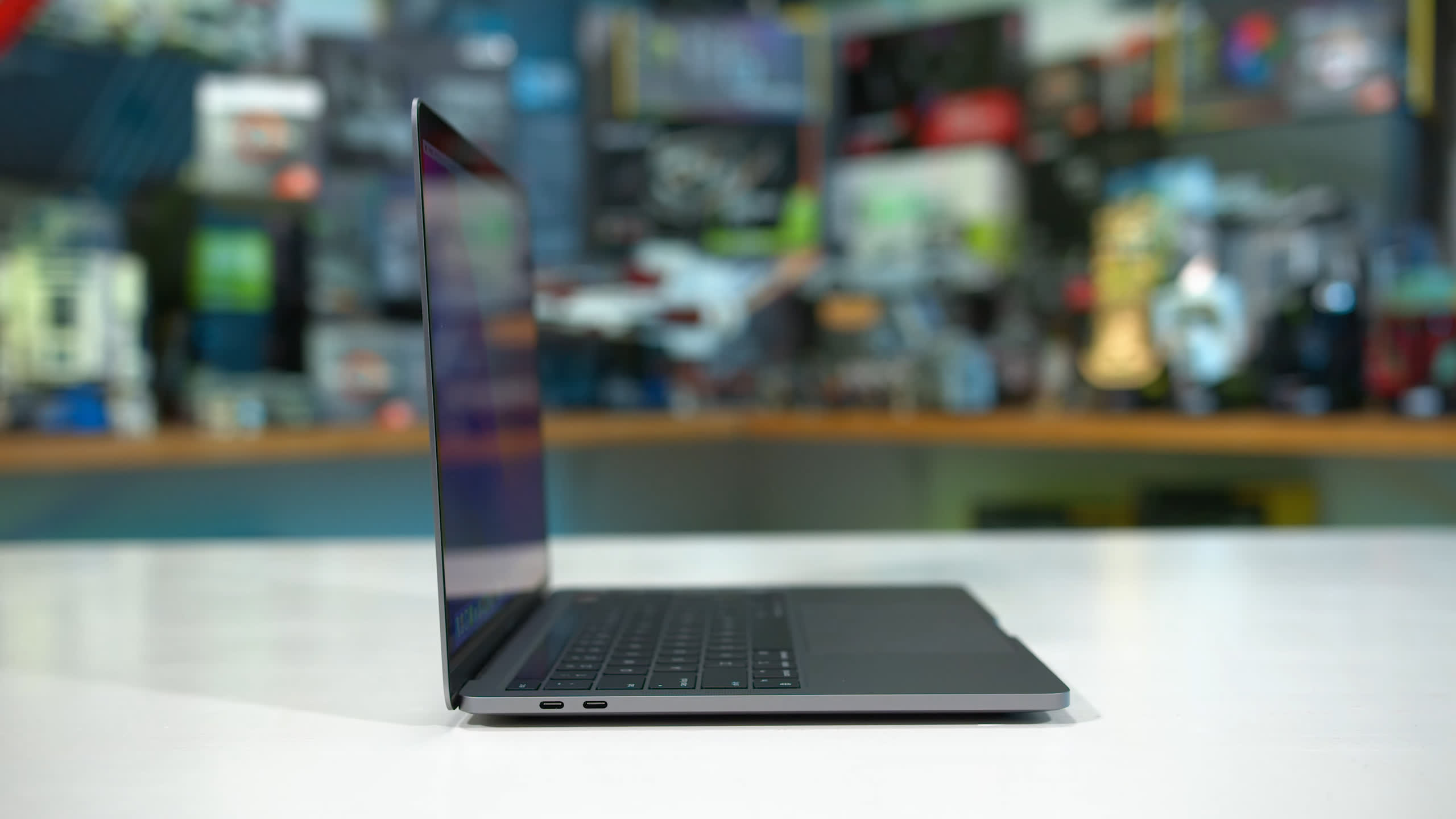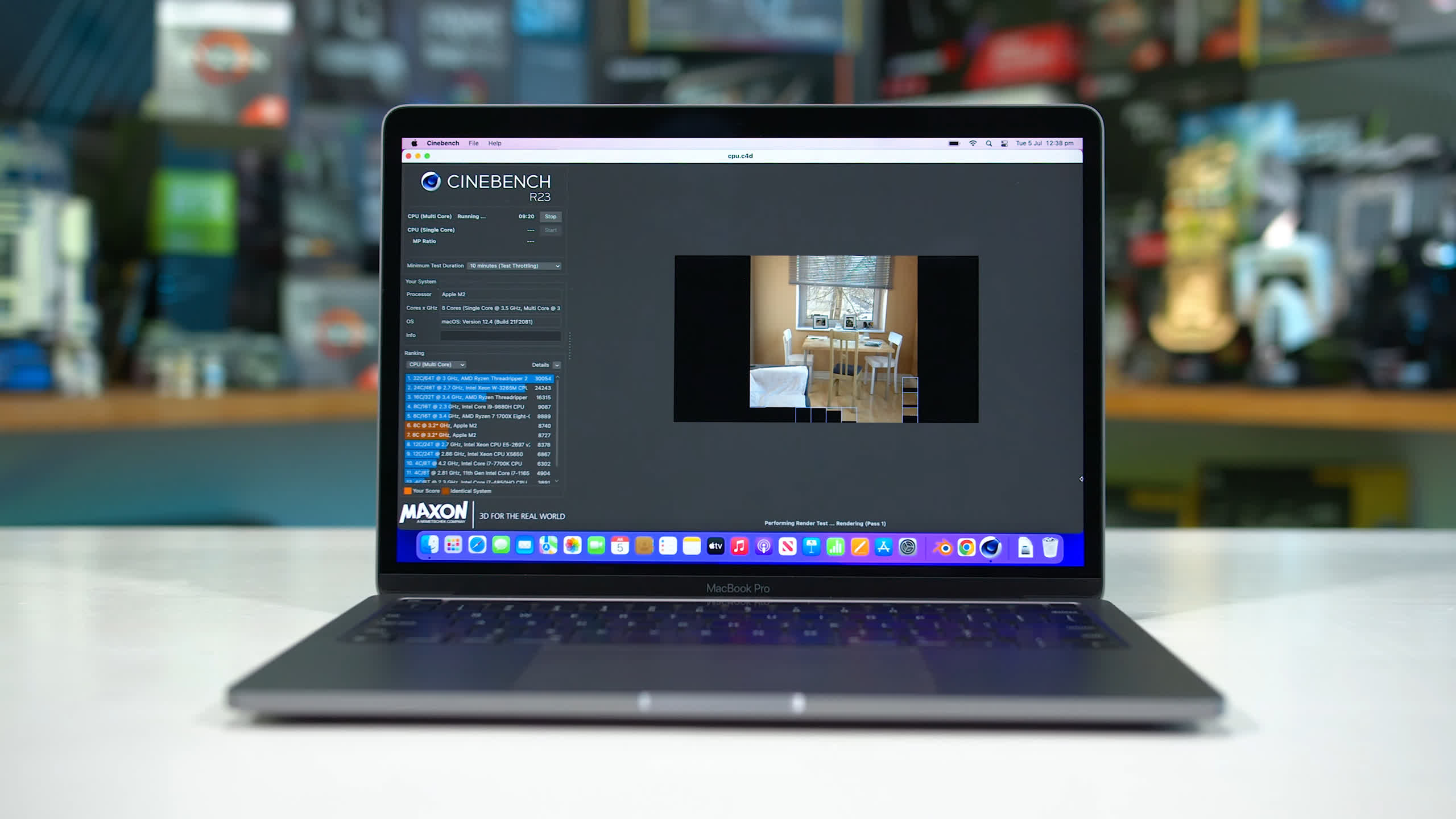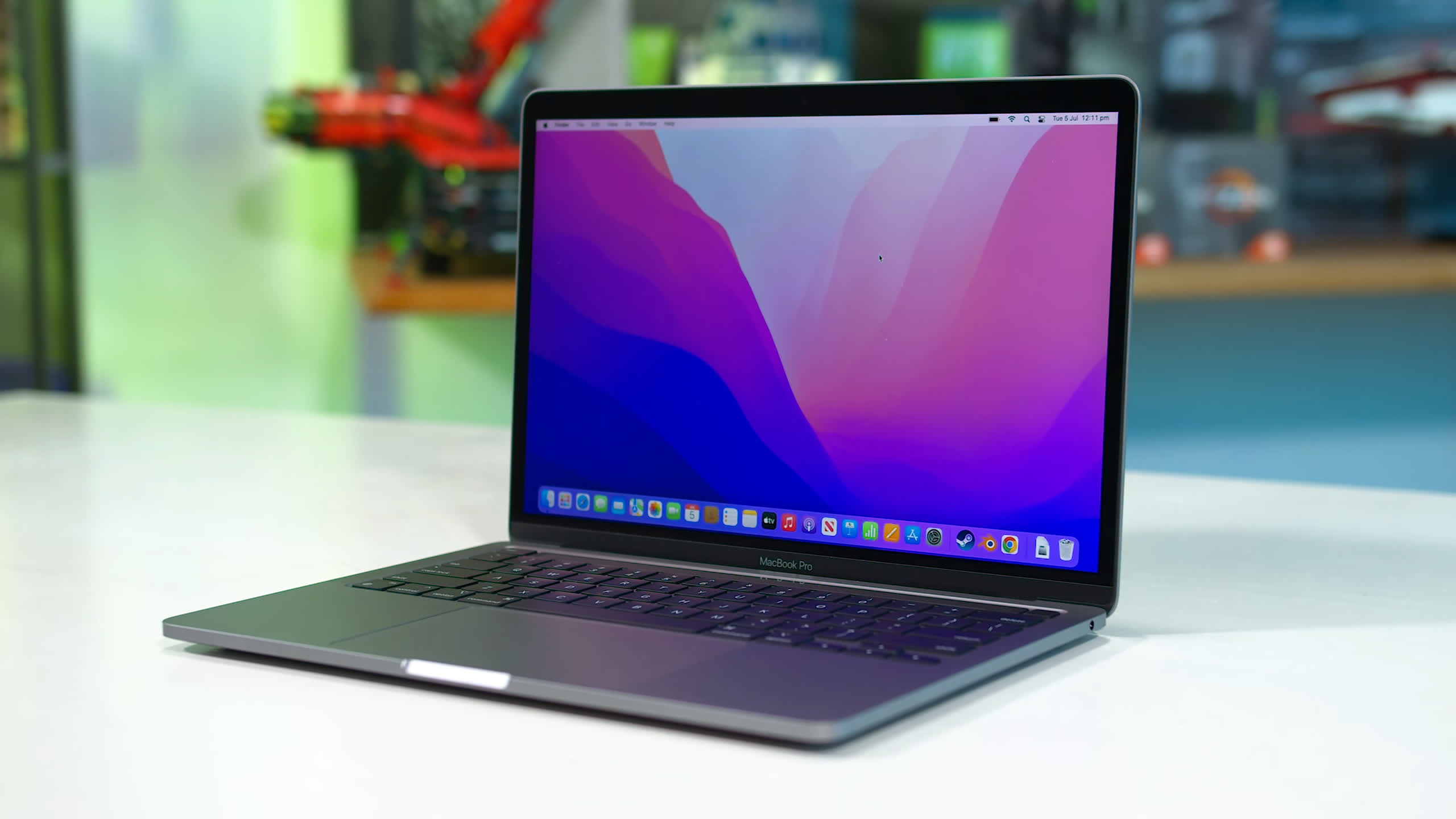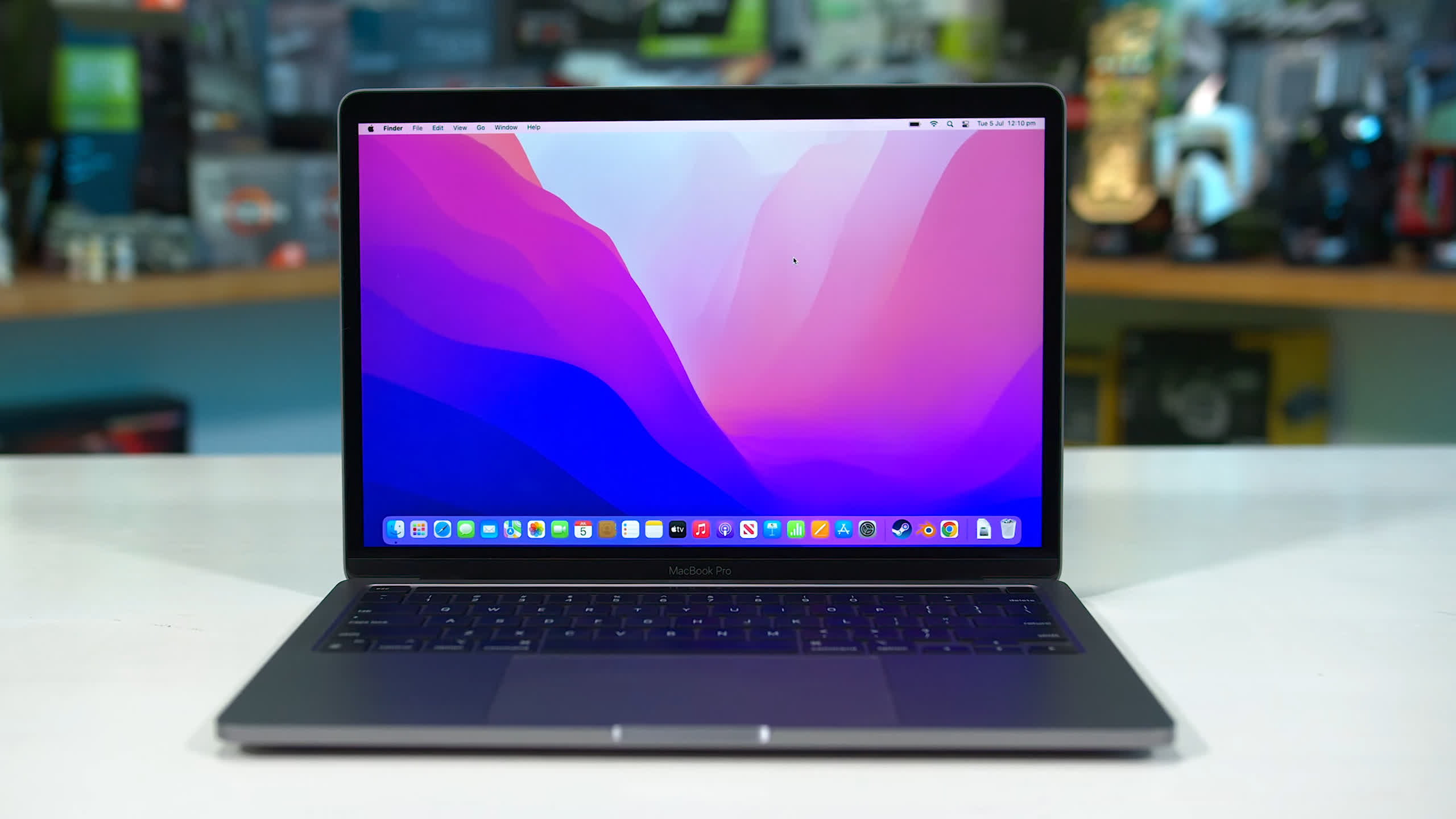The new Apple M2 chip is being touted as a much faster SoC than its competitors, but Apple (like most tech companies) aren’t exactly reliable when it comes to in-house benchmarking, so we’ll have to see for ourselves. Like our previous review of the M1 Pro, we’re interested in how the Apple M2 performs across a selection of cross-platform applications, so we can compare it to the best parts available in the Windows world. Comparably, that means machines packing the AMD Ryzen 7 6800U and Intel Core i7-1260P.
Apple’s new M2 SoC has been integrated first into the refreshed MacBook Pro 13. Because this isn’t a laptop review, we aren’t going to evaluate the MacBook Pro 13’s credentials as a laptop — we’ve seen how Apple’s been copping some criticism for its outdated design, but we’re not concerned about that on this review.
The M2, like all Apple Silicon products, uses the Arm architecture instead of x86 that we see deployed for the vast majority of Windows systems. The CPU portion includes 8 cores, split into a 4+4 layout: four high performance Avalanche cores, and four efficient Blizzard cores.
This is the same 4+4 configuration as the M1, but with updated cores, and it contrasts to the M1 Pro and M1 Max which use more performance cores, but fewer efficient cores. That’s because those chips are designed for high performance productivity systems, while the M2 is destined for ultraportable machines. The performance cores are clocked up to 3.5 GHz, slightly higher than its predecessor.

The integrated GPU arrives in two configurations: one with 8 GPU “cores” and another with 10 GPU cores. We’re testing the 10-core variant. On the memory subsystem, it’s LPDDR5-6400 over a 128-bit bus, providing just over 100 GB/s of bandwidth; an upgrade on the M1 that used LPDDR4X, but without as much LPDDR5 bandwidth as the M1 Pro and above. The M2 also receives Apple’s powerful media engine and neural engine.
As we like to mention when we see this happen with other tech products, we find it a bit silly that Apple use the same M2 name for two distinctly different CPUs that vary in GPU configuration. While Apple doesn’t hide these specs, we feel it would be easier for consumers if the naming was different for each chip.

For testing we purchased a 13-inch MacBook Pro with the full M2 configuration. We’ve also chosen 16GB of memory to match other systems that we’ve tested, and opted for a 512GB SSD because the base configuration that only has a 256GB SSD is a bit ridiculous in 2022.
Like most Apple products, upgrading to higher memory and storage configurations costs a disgusting amount, and there’s no user upgradeability to speak of.

Today we’ll be comparing the M2 to our existing data of AMD and Intel CPUs, which is all power normalized to the default TDPs of those chips. There are of course some challenges in testing, namely that not all applications we benchmark are available on macOS. We’re only including cross-platform benchmarks with a macOS version, whether that’s a native Arm version or an x86 version emulated on Apple Silicon via Rosetta 2. At this point the majority of apps we test have a native Apple Silicon version.
This immediately introduces a variable in that Windows and macOS versions of apps will work slightly differently, but it’s the best alternative available given the circumstances, so let’s get to the testing…
Power vs. Performance
We’re going to start with the power numbers because this will set the expectations for the performance benchmarks we have coming up.
In Cinebench R23 multithreaded we recorded 23 watts of power draw from the wall after subtracting the idle power usage of the system. This puts the general CPU package power between the two configurations of the Ryzen 7 6800U that we’ve tested, at 15W and 25W. What this suggests to us is the M2 is most equivalent to a 20W configuration when the CPU is heavily utilized, which is a typical number for an ultraportable 13-inch notebook.


The M2 is extremely impressive in how little power it uses for single-thread applications, just like the M1 Pro was. While the M2 is slightly more power hungry than before due to a small increase in frequency, it’s still using far less power than the next best configuration.
We’re looking at less than half the system power of the 6800U and an even larger gap to the Core i7-1260P. The fact that this Arm chip only clocks up to 3.5 GHz versus 4.7 GHz for the AMD and Intel chips has big implications for efficiency as most process nodes are better optimized for mid-3 GHz frequencies than anything above 4.5 GHz.

When gaming in Shadow of the Tomb Raider and hitting both the CPU and GPU, the M2 consumes somewhat more power than when we’re just utilizing the CPU heavily.
The M2 is now closely equivalent to the Ryzen 7 6800U running at its highest 25W power configuration, though the M2 is still using less power than Intel’s Core i7-1260P at 28W and generally there’s no issues with this level of power. Modern laptop designs are more than capable of running in the mid 20W range and the MacBook Pro 13’s cooling is good enough that the fans rarely have to activate – though on occasion we did notice the fans running at a high RPM, usually during the heaviest workloads.
Performance Benchmarks
Let’s kick off the performance testing with Cinebench R23 multi-threading. In this workload the M2 puts up a reasonable showing, matching the Core i7-1260P despite running at a much lower power level. Compared to AMD processors, the M2 is similar to current-gen parts in both performance and efficiency. The power consumption level is between the 15W and 25W configurations of the Ryzen 7 6800U, and so is the final performance. What we’re seeing is Apple can keep up with today’s best mobile processors, but not exceed them.


In the single-threaded test, the M2 is very competent. A score of 1580 points exceeds that of the M1 Pro and also beats the Ryzen 7 6800U by 9 percent, putting its performance more around the mark of the Ryzen 9 6900HS. However, despite an upgrade to the core architecture, the M2 is still beaten by Intel’s Alder Lake line-up, including the Core i7-1260P which is 8 percent faster in this workload.
The way Intel is able to achieve this is by using higher clock speeds which push up power consumption; as a reminder, we just saw the 1260P’s single-thread power consumption is over 3x higher than the M2 and AMD isn’t much better, using over twice the power for slower performance.

The M2 is not great at CPU-based video encoding in Handbrake. This is a heavy multi-threaded task that utilizes AVX instructions on x86 processors, which appears to give them an advantage over Apple’s Arm. The Ryzen 7 6800U in its 15W configuration is 17 percent faster despite using less power, and several other parts are also superior, including Intel’s 1260P.
As a reminder, this benchmark specifically does not use hardware accelerated encoding, that’s not the point of this test as we wouldn’t be testing CPU performance and the final output would be different for each product due to the quality differences of each hardware encoder.
A few people commenting on the M1 Pro review seemed a bit confused by this, but basically testing hardware encoding properly is very difficult if you want a fair comparison because the fastest encoding settings often differ wildly in output quality. And in any case, if you wanted to perform hardware accelerated transcoding you shouldn’t use Handbrake, we’d recommend DaVinci Resolve, which in our testing is consistently faster. Using DaVinci the best we can say is that hardware encoding performance is similar between each CPU but depends on the quality settings you choose.

In Blender we’ve shifted to using version 3, the latest version, and the new Open Data benchmark that goes along with it. That means we’ve only tested a small sample of processors so far, but we can still learn a few things here from the CPU encoding variant of the benchmark.
The M2 shows similar results to what we saw in Cinebench, noting that both are native Apple Silicon apps now. The M2 sits closer to the 15W version of the 6800U than the 25W version, but nevertheless outperforms the 1260P.

It’s a different story for GPU encoding. In this productivity test, the M2 is quite a bit faster than the 6800U, coming in 41% ahead. AMD’s graphics have been historically weak at a lot of productivity based work, but whether it’s raw performance or optimization, the M2 has a large advantage in the ultraportable class.

In Matlab the M2 performs similarly to the M1 Pro using the built-in benchmark. This is one of the last remaining apps that doesn’t have a native Apple Silicon version, so emulation is required and that hurts performance. The Core i7-1260P ends up 12 percent faster, which is not at all terrible with emulation but we suspect it could be better were this app native.

In our Microsoft Excel benchmark the M2 is fast, slightly outperforming the M1 Pro in what is a good test of the CPU’s cache capacity and performance. The M2 is 6 percent faster than the Ryzen 7 6800U and 21 percent ahead of the Core i7-1260P, placing in in the lead among ultraportable class processors that we’ve tested.

7-Zip compression shows another strong result for the M2. While it’s not close to the M1 Pro with its 8 performance cores, the M2 is still able to beat the Ryzen 7 5800U and 6800U by 10 percent. The Core i7-1260P is even further behind putting in quite an unimpressive result.

However for decompression the story is inverted, now it’s the M2 that is the least impressive part of the current generation models. The 6800U is a real beast in this workload, delivering 53 percent more performance in its 25W configuration. The 1260P is also 19 percent faster, though this looks less impressive given the 1260P uses more power than the M2. The AMD CPU does as well, but at least you get a big improvement in performance there.

Since we last tested Acrobat PDF exporting, Adobe has updated the app with native Apple Silicon support and performance improvements on all platforms. This makes the same PDF to PNG export run a lot faster now, which warrants a re-test. In this workload, the M2 is pretty close to other competing CPUs in what is still a lightly threaded task. However the 1260P is 7 percent faster and in the leading position, while the 6800U is 4 percent faster. Not earth shattering margins so like I said, close between these parts.

In FL Studio it’s relatively close between the M2 and other mobile processors, although the M2 is the slowest part of the latest-gen CPUs that we’ve tested. The Ryzen 7 6800U is 16 percent faster in this workload when configured at 25W, and 12 percent faster at 15W, while the 1260P is 6 percent ahead.

Among integrated graphics solutions, the M2 is a beast for Adobe Premiere and this is really where the accelerators that Apple are using show their strength and power. In the overall score, the M2 crushes low power models like the Ryzen 7 6800U and Core i7-1260P, even outperforming 45W CPUs like the Core i9-12900HK.


A lot of this comes down to the extremely strong live playback performance, thanks to hardware acceleration for popular editing codecs like ProRes. But even for exporting, the M2 is an excellent choice, delivering the performance of an integrated GPU 45W solution at just 20-25W. Premiere performance – and by extension other video editing apps – are a massive selling point for Apple Silicon devices.

The M2 also performs strongly in Gigapixel AI image upscaling, though not as well as the M1 Pro or laptops that use discrete Nvidia graphics, as you can see from the chart. As far as integrated GPU solutions go, the M2 outstrips the 1260P by a slim margin, both CPUs include hardware accelerated AI processing. The 6800U at 25W, which does not include AI acceleration, falls behind at 8 percent slower, which isn’t a terrible result as the GPU is still a good fallback.

Our final productivity workload is Agisoft Metashape, a photogrammetry benchmark which is mostly run on the GPU. Here the M2 again flexes its muscles, completing the task 27 percent faster than the Ryzen 7 6800U at 25W. That’s not as much of a margin as in the Blender GPU accelerated benchmark, but still a substantial difference given both products are running at roughly the same level of power consumption for GPU accelerated tasks.
One Gaming Test
As for gaming, you probably shouldn’t choose a Mac for gaming as the majority of games are not supported on macOS, and many won’t even run through emulation. But one game that can be run is Shadow of the Tomb Raider, which allows us to get some basic gaming performance figures.

Using identical quality settings, the M2 is slightly faster for playing this game than the Ryzen 7 6800U when both are running at a similar level of power consumption. Looking at average frame rates, the M2 is 8 to 10 percent faster, which is quite impressive given how powerful the RDNA2 graphics is inside the 6800U.
Battery Life
Battery life is the one of the most impressive aspects to the MacBook Pro 13’s performance. In a YouTube 4K playback test in Google Chrome, the M2 powered system lasted over 40% longer per watt/hr than the next best system that used the Ryzen 6800U. We’re using per watt/hr metrics here to normalize for battery capacity, so that larger batteries are not significantly influencing the results.

This does give the Mac a definitive lead in battery life for this test and for most applications in general. It’s hard to deny that battery life is very strong from this laptop. It also benefits from not dropping performance on battery, which often when you’re using an AMD or Intel powered system you will see lower performance when run on battery, but this isn’t the case with the MacBook, which is again quite a strong result and points to its strong efficiency when run on battery.
Apple M2 vs. AMD vs. Intel
The Apple M2 is a very interesting processor that provides something different than the norm compared to the usual PC parts from AMD and Intel. There’s no doubting that it’s a strong performer in a number of areas, but it doesn’t always have the edge that you might expect, especially if you’re prone to slurping up hype.
The CPU, comprising 4 performance and 4 efficient cores is quite capable, but is perhaps the weakest area to the M2’s package relative to the current crop of x86 laptop parts. Across the dozen or so productivity benchmarks we ran, multi-thread performance was typically around the mark of AMD’s Ryzen 7 6800U, while single-thread was between the 6800U and Intel’s Core i7-1260P.

The M2 has a good balance between multi and single-thread speed, but doesn’t deliver the outright best performance in either category. This was somewhat surprising given Apple’s node advantage, with this chip being built on TSMC 5nm, a generation ahead of what AMD and Intel are currently using; we were hoping this would bring class-leading CPU performance.
However, other areas built into the chip are very strong. GPU performance is impressive, beating the Ryzen 7 6800U’s integrated RDNA2 graphics and offering capabilities more in line with a low power discrete GPU, especially for productivity tasks. While we don’t think the M2 is a great gaming platform due to a lack of compatibility, this SoC in its 10-core variant is very impressive in workloads like Blender or Agisoft Metashape that are GPU accelerated. It should be noted that to achieve this performance, Apple is using quite a lot of transistors – 20 billion for the M2, versus 13.1 billion for the 6800U – so we guess that result should be expected to some degree.
Where M2 Excels (and Where it Doesn’t)
Undoubtedly, the best area to performance comes when all of Apple’s accelerators can be used in tandem, and that’s usually the case in video production where the M2 is at its best. For video creators we think this is hard to beat, thanks to features like ProRes hardware acceleration, a fast GPU, and relatively low power consumption which allows for near-silent use while editing. macOS also has a good ecosystem of video editing apps, so this is definitely the strongest use case we can think of for M2-powered laptops.
Bringing everything together is excellent for efficiency. Single-thread performance per watt is astoundingly good and destroys the competition, while multi-thread CPU efficiency is around the mark of AMD’s Zen 3 parts, and GPU efficiency is strong.

With these sort of results, the MacBook Pro 13 is comfortable in not reducing performance on battery, whereas most Intel and AMD systems will throttle down the available power to conserve juice. This leads to both excellent performance away from the charger, and excellent battery life. x86 CPUs have a fair way to go to match these capabilities.
So, what are the downsides? To access this level of performance and efficiency, you’ll have to fork over a lot of money. While the MacBook Pro 13 starts at $1,300, that’s for a configuration with too little memory and SSD space. To get the model we tested with 16GB of RAM and a 512GB SSD, which corresponds to a part this powerful, you’re looking at spending $1,700 which is a lot. The MacBook Air coming shortly will be no different. In contrast, the Asus ZenBook S 13 OLED we tested to gather our Ryzen 7 6800U performance data is $1,300 for a configuration that actually has a larger SSD. This makes opting for a MacBook 30 percent more expensive than a very decent Windows laptop.

The other potential downside is macOS and the general Apple ecosystem. You might think differently, of course. When we polled our primarily Windows audience a year ago on whether you’d consider switching to a Mac, nearly half of the 271,000 responses said they’d never consider switching, and a further 36% said they would need to be substantially better to consider.
This presents a hurdle for Apple in getting enthusiast PC users that care about Apple Silicon vs. x86 performance. Whether or not the results you’ve seen today count as “substantially better” is up to you. Personally, I tried using the M1 Pro MacBook Pro last year and despite its excellent performance and battery life, ended up switching back to Windows after about two months only because I very much prefer Windows to macOS. I also know those who have effectively made the switch, but only for productivity, not for gaming. If there was an effective way to run Windows on MacBook hardware without destroying its capabilities, I’d certainly consider switching to Apple hardware.
What we’re curious to see moving forward is how x86 chip giants will respond. We expect to see new processors from both companies in about six months, or around the start of 2023 – and at least for AMD that will bring a significant step forward to using TSMC’s 5nm node, the same as Apple is currently using. How the Apple M2 will fare compared to next-gen chips without a node advantage will certainly be something to keep an eye on.
Shopping Shortcuts
- Apple MacBook Pro 13 on Amazon
- Apple MacBook Air M2 on Amazon
- Asus ZenBook S 13 OLED on Asus
- AMD Ryzen 7 6800U Laptops on Amazon
- Intel Core i7 Alder Lake Laptops on Amazon
- Apple MacBook Pro 14 on Amazon
- Apple MacBook Pro 16 on Amazon

